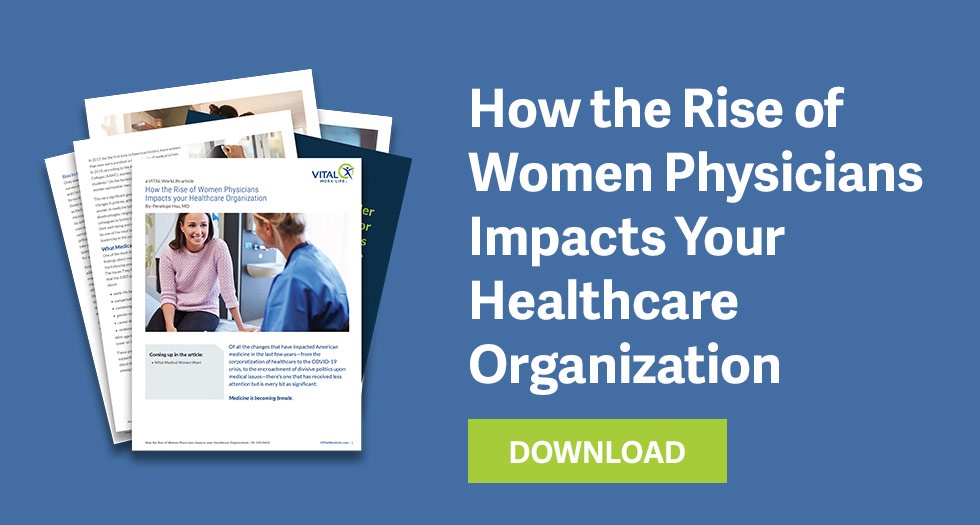As a new attending physician, Dr. Madeleine “Maddy” Lee discovered she was between a rock and a hard place. She was a mother and at the same time, an ambitious surgeon. She was committed to being a real presence in the lives of her daughter, Josephine and her new baby boy, Micah. That meant putting limits on her work hours at Methodist Hospital. She was told by more than one of her colleagues, male and female, that physicians with reduced hours rarely advanced at Methodist—or, for that matter, anywhere else in healthcare.
It was just one of the hurdles women faced in the profession. There was a lack of signs of respect—sometimes patients mistook female physicians for nurses or asked for “a real doctor.” Women struggled with compensation, as they were often offered lower salaries than their male counterparts and experienced a lack of advocates during the hiring process which affects women more substantially. They also tended to spend more time with patients—patients respond to the fact that women often display a high level of emotional intelligence by trusting them and asking them more questions than a male physician might. All well and good, except for the fact that it brought down women’s per-encounter pay totals.

All systemic issues—issues created in systems–established and operated, for the most part, by men.
With the help of a peer coach, Dr. Lee found a potential path to realizing some of her career ambitions—a path that was, paradoxically enough, rooted in her problem. She decided to become a Well-Being Advocate to mentor and encourage women who were starting out as practitioners. She wanted to support young women who were meeting the very problems she faced as a resident and a new hire, problems she continues to face even as a seasoned professional.
It wasn’t easy. It meant reducing her clinical hours, adding time to train as an internal advocate and working with young women who were often at a loss about how to build a career. Dr. Lee was wondering how to balance this while she scrambled to spend quality time with her children, Micah and Josephine.
One new attending, Dr. Gail Koyama, connected with Dr. Lee when she realized the elusive work-life balance issue was depressing her to the point of despair.
“I feel guilty when I leave the hospital a little early—and by a little early I mean after ten hours instead of eleven, to go spend time with my kids,” she said. “And then I feel guilty again when I leave home at the crack of dawn and my partner Russ has to make them breakfast. I’m so distracted and tired when I meet a patient that I feel like I’m giving, I don’t know, fifty percent to this calling I’ve had all my life. Then rinse and repeat and worry about burnout.”
During the meeting, Dr. Lee suggested she engaged with their hospital’s resources from VITAL WorkLife to connect with a physician peer coach like she had. Dr. Koyama's coach reminded her that she was a well-trained, vividly intelligent professional who was making real contributions.
Through peer coaching, Dr. Koyama discovered how to make the crucial distinction between the things she could change in her work life and the things she couldn’t.
She could, for example, limit her time with patients, as painful as that might be for a dedicated female practitioner. She could learn negotiation skills and put them to use when salary was at issue. She could politely insist on being treated with respect.
But there were days when Dr. Lee felt that she was simply applying band-aids to a larger wound. What about the things struggling physicians like Dr. Koyama “couldn’t change?” Like the traditions and policies that meant that physicians who didn’t work full-time were almost considered less successful practitioners? Or the scheduling procedures that made it hard for doctors who were mothers to meet their obligations? Or the male dominated culture that pervades many areas of medicine, making misogynistic comments or jokes okay and all but forcing women to become “one of the guys” or face a subtle form of ostracism?
These things, and others, needed to change, and if they were going to, then they had to change from the top—and that meant that more women needed to be in positions of leadership. But female practice leads, medical directors, administrators were few and far between.
Could Dr. Lee become such a leader? When she considered how overstuffed her life was—she had a full day of surgeries scheduled tomorrow, and she needed to help Carl get Josephine ready for summer camp, and the baby wasn’t sleeping well, and the house needed to be cleaned (somehow!)—it seemed pretty unlikely.
But she had done hard things before. Like med school. Like residency. And her commitment to her fellow females in medicine was becoming as important to her as her commitment to medicine itself.
So maybe—probably—no, really—there was no turning back.
The story continues in part four, when we see Dr. Lee five years later, in a leadership role and helping implement systemic change within her healthcare organization.
Well-Being Advocates are just one resource included in your Physician Well-Being Resources from VITAL WorkLife. Learn more today to create a positive culture at your healthcare organization, for all.



